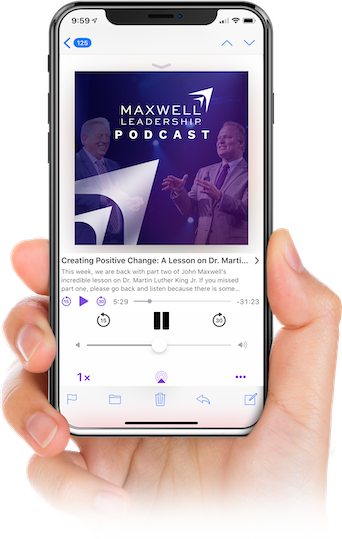Maxwell Executive Leadership Podcast #48: A 4 Phase Approach To Leading Leaders

Leading leaders brings its own challenges and often requires a new mindset. In Episode #48 of our Executive Leadership Podcast, we explore how you can become an effective second, third, or fourth-line leader while helping those underneath you grow.
To learn more about leading leaders, consider bringing a 5 Levels of Leadership Workshop to your organization this year.
Read the transcript below:
Welcome to the John Maxwell Executive Leadership Podcast. Our goal is to help you increase your reputation as a leader, increase your ability to influence others, and increase your ability to fully engage your team to deliver remarkable results. Hi, I’m Perry Holley, a John Maxwell facilitator and coach, and I’m Chris Goede, Vice President of the John Maxwell Company. Welcome and thank you for joining. Just as a reminder, everything we talk about on this podcast is in reference to the 5 Levels of Leadership. And if you would like to learn more about the 5 Levels of Leaderships or perhaps bring a 5 Levels workshop to your organization, please go to JohnMaxwellCompany.com/podcast and if you’d like to leave a comment or a question, Perry and I would love to see that, respond to that and maybe even address it on one of our future podcasts.
Today’s topic is titled, “A Four Phase Approach to Leading Leaders.” We focus a lot on this podcast on making the leap from the individual contributor to becoming a first-line manager or first line leader. But there’s another challenge and you and I were just talking about we could really spend a lot of time talking about this, where leaders need a bit of a different mindset and that’s where you move from that first line manager or leader to become a second or third. And how are you leading those first-line leaders? We’re very excited to talk a little bit today about this topic and introduce it to our audience.
And it came up as a challenge to me as in a lot of our coaching work we’re talking to second, third, fourth line executives who have leaders reporting to them who have either individual contributors or other leaders reporting them depends on how high you are. and I actually flashed back to myself when I became a first-line manager for the first time. I had lots of opportunities to grow my leadership capabilities. I was managing a group of individuals. I learned how to engage. I had all the challenges that you have in that role.
Then I got promoted and I became a second-line manager and I had these first-line managers reporting to me. I thought things would get easier. Wow. Everybody’s handling the hard stuff now, I can sit in my thinking chair and just imagine the future. No, I’m now leading leaders who are now doing the hard things and they have the individual contributors and my whole leadership now is gone to another level of this. Actually, the whole idea of 5 Levels Influence. My influence is a lot more important than my title. And my position is as boss no matter how high I go.
John says, and we get challenged on this sometimes when we talk about the 5 Levels. When you get to Level 4, John says that the higher you go, the easier it is to lead. And so we’ll just kind of leave that comment there and people are like, oh, I disagree with that. I disagree with that. Well, what John’s really talking about is the higher you go, it doesn’t get easier to lead. What he’s really talking about is that the higher your influence is with people, the easier it is to lead them personally.
What we’re really talking about, again, comes back to this Level 4 mindset in this skillset of developing people. And it made me think about the law of explosive growth where John says to add growth, lead followers to multiply your growth, man, we’ve got to figure out how do we lead these leaders when we start, you know, we focus on our development as peoples, we’re an individual contributor. What do I need to be doing and growing myself?
And while you always should do that, don’t hear me say you shouldn’t ever stop growing. Because if you hear me say that, I may not be on the next podcast, right? I may be out on the streets. But I want you to also begin focusing on the development and leading other leaders. So, when I think about the law of explosive growth, there’s just a couple of mindset things that I want to share with you as we kind of kick this off. John says there are three things that are kind of grabbed out of the explosive growth chapter. He says, make sure mindset now you want to be succeeded, not needed. So when you’re leading leaders, listen to me. Okay? It’s a challenge. You’re going to leave, eventually, and you need great leaders on your team.
Make sure you want to be succeeded, not needed. The second one I wrote down was to treat and lead individuals differently. Not the same. We’ve talked about this in the past. We can’t lead everybody the same way and you definitely can’t lead leaders all the same way cause they all have different methods. And then the third one, make sure you invest time in people, not just spend time with people. There’s a big difference between John and Paul. This a little bit about the difference between investing time with your people, especially your leaders, not just spending time with them. So those are kind of just initial kickoff thoughts. So, Perry, why don’t you walk us through your 4 Phase approach to leading leaders and let’s give them some tools and some handles to work with.
And that’s because I’m a simple guy and I needed something to help me. And so, I’m just sharing what I do, and it’s been very helpful for me. I’m going to challenge you, Chris, if you wouldn’t mind, I’m going to tell you what the phases are in the 4 Phases. Every one of them has a challenge I think for the leader in there. I want you to, we’ll do point-counterpoint. I’ll give you the phase. You tell me the challenge.
Phase 1 I call frame it and that means that I need to outline the outcome that I’m looking for the team to accomplish. You can call it your vision; you can call it an outcome. But really, what does a win look like? I think every leader that is underneath you needs to know what a win looks like. Show them the picture on the top of the puzzle box and you might go as far as to help them identify the corner pieces and some of the side pieces but not do the whole puzzle for them. But I think that helping people understand what it is we’re aiming for is the first step to leading leaders.
I think the challenge here is that as leaders, as leaders, we make an assumption that our team, after the first time, gets it. We assume that everyone knows where we’re going and the road to get there as obvious because it’s obvious to me, right? And we need to understand that they don’t and that it’s on us and we must constantly be framing. I was talking to Mark Cole, our CEO just the other day with some organizational challenges and opportunities that we’re going through and we kind of just went back and forth about the fact that hey, no matter how common it is in your head, it makes me think about that, that kid’s game, you know, where you tell somebody something in a room and by the time it gets back around in the circle, it’s not even the same color, the same topic.
And it’s the same thing with leaders and casting that vision. We’ve got to make sure that we are doing it constantly. Every opportunity, using different mediums, verbally, email, visually, whatever that might look like. I know John says, how often do you cast vision? Constantly. I thought, no, I can’t. No, they don’t. You think they got it? They don’t. So, keep talking about it. Keep framing it and then release these folks.
Number 2 of my 4 Phases is to empower and release your leaders to tackle the “how”. You know, once they’re in agreement with you on the outcomes that you’re going for, then you should allow them to develop the execution plan to get there. If you tell them how to get there, guess what is your plan? If it’s wrong, guess what? It’s your fault. So, if I can empower and release, that’s why I hired you. That’s why you’re in that role. Here’s the frame for what it looks like. I want you to go for it now. Tell me how you’re going to get there.
We need to be able to do that, especially when we’re working with leaders to foster empowerment and autonomy. Just yesterday, we were as an organization going through some of John’s leadership content and there was a topic where he basically said, you need to encourage courage. And the way to do that is to allow them to make those mistakes, allow them to do their own thing, empower them. But too often as leaders, we don’t want to do that. We don’t want to empower, we don’t want to release them because we want to kind of hold everything tight because we think, man, if we have control of everything, we have great job security.
And I’ll go back to this statement that John said to me a long time ago back. You know, I’ve been working with John for almost 20 years now, so I started when I was four. So I think I was five or six when he said, hey, work yourself out of a job and I’m going to find another job for you. If you don’t, you might not have a job. And I didn’t get it back then, but I get it at this level. So many senior executives, they just want to hold on too tight and we just need to let go. We need to be wise about it. But then once we’ve done our part with them, we really have to let go. I’ve been surprised by the number of senior leaders on coaching calls that tell me they still struggle with delegation.
And giving work to others, you’ll say, why? It takes longer. They might not do it right. I’m on the hook for it. I need to make sure it gets done. And I just would tell you that if you’re struggling with that and empowering, releasing your executives to go to do their jobs, you’re going to have a very tough go of it. So, Phase 3, you first frame it, then you empower and release, then you track and measure. I found this to be best in regular one-on-one communication with my leaders to really review, first of all, the plan they have to get to what I framed. And secondly, what is the progress you’re making every week to do that? I’ll ask them, what are the most important tasks you’re going to be working on?
What are your people working on? I don’t need great detail here, but I just want to know, how are you thinking? What is your process for thinking this through and what are you doing? I’d like to know the actions you’re taking, not just for my own comfort, but also to open doors for coaching moments and mentoring moments and teaching moments to really help them and come alongside them to ensure their success. Yeah. If you don’t do that on a routine or a regular basis, you’re not sure that they’re even taking the right actions. The word that comes to mind to me is, are we in alignment? Right? And one of the great ways to find out if we’re in alignment, whether we have a virtual team member or whether you’re face-to-face or whatever it is, is to have that inner interaction on a regular basis.
Maybe it’s not weekly for you, but you got to make sure that you’re in alignment because they could be producing, and they could be going 100 miles an hour and they think that they’re absolutely hitting it out of the park. And you could get to the end of the quarter and go, no. It reminds me of the illustration, where they say, hey, let’s talk about a plane leaving LA headed to Atlanta. And one of the dials is just off by 1/10. Well, when you’re leaving LA and you’re getting out of California, you’re not that far off. By the time we get to the end of the first quarter and we’re supposed to be landing in Atlanta, there’s the potential we could be in Charlotte. And that’s a big problem, right?
And so, we need to make sure that we are having that one-on-one communication. I love when we talk about virtual teams, especially when your teams are remote and virtual because you need to have that interaction to make sure that everyone is in alignment. Any airplane flight of any length is a constant renewal. The wind is blowing, the earth is rotating and the altitudes, the weather, the headwinds, tailwinds, you’ve got things that are affecting, and you’ve got to be making a course correction.
So, number 4. We first, number 1, we framed it. Number 2, we empowered and released. Number 3, we tracked and measured. And then finally, number 4 is the coach and mentor. It’s to really maintain an open door or they can come through for help and insight. Of course, if they’re not performing and the measurements are not being met from Phase 3, then your coaching can become a little more prescriptive. But I’m finding that most of the leaders that you put in in leadership roles underneath you, so you’re a second or third line. It really is that you need to transition your mindset from a telling, teaching to really being a coaching mentor and helping them to grow as executives, as well as grow as business people.
I find it to be a great place to teach 5 Levels to really help them climb the Levels with their people. That way you’re doing it with them. And are the challenge there for us as leaders, because we probably have been there and done that in most cases. We just want to tell them, right. They come to us and this coaching and kind of mentoring, the challenge is I don’t think that we create a culture that allows people to think. And so they come and they want an answer and you give them the answer. I have a team member on my team, and she challenges me all the time and I love it because she’ll say, hey, how’d that meeting go? Did you get what you needed out of there? When they brought that issue to you? Did you let them answer first?
What she’s saying to me is, hey, what is their solution to what they’re bringing to you? What did they think through? And then how did you coach and mentor to be able to adjust that because of your experience in the situation. I think too many times, the challenge here is that as leaders that we just want to give them the answer and we want to know the answer. Sometimes we don’t. Most of the time we probably do, but we’ve got to help them think through that, especially the leaders we’re going to be developing.
Well, I just wrote an article on my website because of something I noticed in myself, in coaching, is that I’m, by nature, a teacher. I like sharing things and learning with people, but the title of the article was, “Are You Telling, Teaching, or Coaching?” I notice when I’m telling and teaching people aren’t always receptive, but if I’m coaching and asking, I’m drawing more out of them. They can either accept it or reject it, but at least we have a discussion and I’m teaching this. It goes back to the difference between coaching and mentoring. If we’re going to break it down, coaching is the ability to ask questions, to pull it out of them, to make them great. Mentoring is, I’m going to share some things with you, where you’re going, what you’re going through in hopes of being able to help you through that situation.
I love that. Next time I check out your blog there’ll be a test. I’ll turn it back over to you to wrap up. But I just want to encourage our listeners that for the most part, leading leaders is about putting the right people in the right leadership positions. If you’ve done that, then it’s about letting them loose to do the job you hired them to do. ou need to stay out of the way. And then for many of us as a second-line or third-line leaders, this is going to be challenging, because we’re built to be driven and to push things and to own things. You’re letting your influence lead and letting others do the hard work.
But you’ve got to be encouraging and bringing them along. So that’s why I like this 4 Phase approach. It keeps me in a framework to do that. Here’s what I love about you even saying it. It’s 4 Phases. To me, it always goes back to the 5 Levels of Leadership. And this is a Level 4 thing for leaders. We have to become leaders of leaders and we have got to develop them. So as I wrap up, there are three things that I thought about in regards to this lesson that I just kind of want to share with you as you’re listening to this podcast.
The first one is, and I know each one of you is probably going to laugh and think that I’m absolutely crazy when I say this, but we need margin in our life. Leaders need margin. I have an integrity problem right now saying that because my wife would say, well, why don’t you do it? Everybody may have laughed, but they kind of do that. The reason why I say that, and I wrote it down is that my thought is you can equip people on your timeline. But to truly develop people, it’s got to be on their timeline. And you need margin in your life as a leader to be able to do that. And if you don’t have margin, you’re going to miss opportunities, the right opportunities to develop your team in those moments.
The second thought was, we’ve talked about this in the past. I love it. It’s the On It vs In It. As leaders, we get in the business instead of working on it. Working on it is leading leaders, is developing leaders, and we need to be doing that. And then finally, here’s a question that I’ll leave you with. It might sting a little bit, but I’m hoping that this will plant a seed for your mindset moving forward. And here it is. What have you done to ensure that your department, your team, those that you have influence with, will thrive in the future without you? Even to me, answering that question is tough. And so, if you have that mindset when you wake up every morning, I think you’ll see your leaders a little bit differently than you do now.
I heard Andy Stanley asked that once. He said, I love seeing it work without me, and I thought, I wonder how many leaders can say that. So that’s kind of a secure thing to say. I know a lot of my insecurities. I like to see it work because of me. You have to prepare, develop, allow, and release people to do the job you hired them to do. Well, thanks, Chris. Great stuff. And just as Chris reminded you at the front of the broadcast, if you want to learn more about these podcasts, contact us at JohnMaxwellCompany.com/podcast. We appreciate you joining us very much. That’s it for today from the John Maxwell Executive Leadership Podcast.












Be the first to comment on "Maxwell Executive Leadership Podcast #48: A 4 Phase Approach To Leading Leaders"